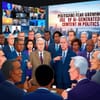Politicians on both sides of the aisle are increasingly voicing alarm over the rapid rise of AI-generated videos, images and texts in political campaigns. With tools available to create hyperrealistic deepfakes, many lawmakers worry that voters may soon be unable to distinguish authentic content from manipulated material—a challenge to the very basis of informed democratic decision-making.
Several U.S. senators publicly voiced concerns that such artificial content could distort public discourse, mislead voters and undermine trust in institutions. Some of the most cited examples include AI-generated videos showing real politicians saying things they never said, or depicting them in fabricated scenarios. The trend is gaining traction not only among political operators but also among adversaries seeking to sow confusion or influence electoral outcomes.
The debate over how to respond is already dividing lawmakers. On one side, there are calls for stronger regulation—such as watermarking AI-generated political media or banning deceptive content without proper disclosure. On the other, there are arguments rooted in free-speech protection that warn against over-broad constraints on political expression and satire. The regulatory balance remains unsettled.
For countries like India and other emerging democracies, the development serves as a clear signal: AI-driven content manipulation will very likely become a key front in future election cycles. Effective responses will involve regulatory clarity, media-literacy programmes for citizens, platform accountability and technological tools for detection and attribution.


